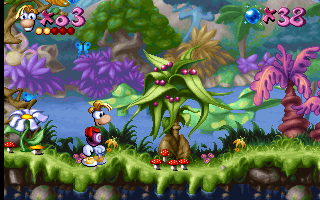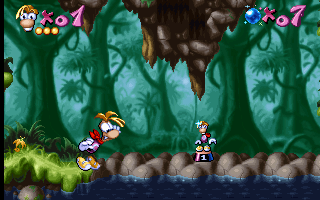For years, thanks to an uneven and sporadic history, Rayman has held a steady position as one of videogaming’s most bizarre characters. It’s not much of an award; it’s like Spinal Tap being known as “England’s LOUDEST rock band”. Rayman’s like some sort of SOY BOMBish upstart, or maybe a less anthropomorphic Steve Allen that keeps trying to make his mark in a buffet layout of different genres. He’s starred in 2D platforming, 3D platforming, educational gaming, golfing, racing, arena multiplayer gaming and whatever the hell Raving Rabbits is supposed to be.
But Raymario this is not; only a few of the products bearing his name are worth the price tag—even while considering that they depreciate in value pretty quickly. Focused more on getting his name into every nook-and-cranny videogame genre except hentai (for now, at least) than on the quality of his merchandise, Rayman was less of a Mario or even Sonic than he was just a freak who keeps showing up from time to time. But there’s one thing Rayman was able to do that even Super Mario almighty couldn’t do in the late 90s:
Star in a kick ass (and ass-kicking), incredible 2D adventure that will leave an impact.
Say what you will about that limbless, overfed, colognically irritating…um…shit, I really don’t know how to end that sentence because I don’t know what to call him…beagle? You want me to call him a beagle? What the hell sense does that make, Paul? Whatever. Anyways, say what you will about the beaver, but the fact is at one point he had a SERIOUS piece of work with his name on it.
Rayman is everything you want out of a videogame, period. The graphics, the music, the design, the layout, the big things, the small things—everything about this game is what you should be demanding out of videogames and videogame developers today. This game was clearly made with the hardcore fans in mind because of the amount of effort that went in. The level layouts, look, on paper or on screen, simple enough, but actually getting through them demands a crazed devotion of your own.
The central theme of Rayman is CHALLENGE. The obvious presentation being in the levels themselves, but even in the aesthetics. The soundtrack is nutty and unpredictable, with songs that start out as light, airy music and might suddenly segue into a jazz horn piece, or start out orchestral and shoot into rock. It’s a soundtrack that challenges you to listen. The graphics, though sickeningly cute, are even more of a front than Jimmy The Wiseguy’s Italian Eatery; they tease you into thinking you’re playing Barney’s Big Adventure when, in fact, you’re playing Contra III with the difficulty shooting through the roof. The graphics challenge you to hold your sanity together as you play a candy-coated monster.
I gush, obviously, and I gush with the optimism that you’ll pick it up and play it for more than a few levels and devote yourself to seeing it through. The chances of that happening are not large, I will admit, because Rayman simply doesn’t have that kind of pick-and-play charisma that the real classics have. Rayman is an acquired taste, and even though the gameplay is carefully and impeccably well designed, that doesn’t mean you’ll be smiling while you play it.
Rayman’s world, which is refreshingly large, considering that the game’s a platformer, has five basic stages with five-to-six or so levels in each stage and any number of screens within those levels within those stages. The stages have themes like forest, surreal music, caverns, umm…stationary? and more caverns. Your main goal in each level is to find the six cages and open them up. Your main conflict is not the enemies in each level, but the level designs, which incorporate, to a very creative degree, all the items you would expect to find in those themed stages, like killer music notes in the music level, bouncing erasers and dangerous pencils in the stationary one, etc.
The main gimmick (and arguably the most frustrating idea in platforming history) is that, in order to find these cages or advance further, you have to jump into or go to a certain part of the level to trigger something to pop up. An example would be jumping into the top-left corner of an enclosed area so you can get a platform to appear (although it’s usually a LOT more difficult). You have nothing to indicate these triggers except your own intuition, and you’ll be crawling through every inch of screen looking for them. There is a huge amount of variety within the Rayman levels while having a strong enough base to not feel way too spread out (as in something like Gunstar Super Heroes), and there is NEVER enough ideas or challenge. It’s truly endless. It’s like having everyone in the whole wide world dressing up like Winnie the Pooh and waiting in line to kick your ass, one at a time.
But with so much intensiveness, it’s hard to really get into the game and STAY there. The challenge is as unforgiving as Old Testament God Almighty. It was my experience to take whole WEEKS trying to get through certain levels. and the only reward you get is…more challenge. All you really get out of this game by the time you finish it (a year later) is the ability to say wholeheartedly “I beat Rayman!,” and only in the UK will anyone even give a shit.
Still, there is no denying that Rayman really stands out in the platforming world. That disembodied head of his got way too big afterward, but at least he really did have something to be proud of. Rayman is a rite of passage; it’s what separates the casual gamer from the hardcore, and it should be a required course in every game development college on the planet. I’m giving this game…
FOUR STARS!!!!!!!!!!!!
…out five….
an·a·lyt·ic [an-l-it-ik] –adjective
1. pertaining to or proceeding by analysis (opposed to synthetic).
2. skilled in or habitually using analysis.
3. (of a language) characterized by a relatively frequent use of function words, auxiliary verbs, and changes in word order to express syntactic relations, rather than of inflected forms. Compare synthetic (def. 3), polysynthetic (def. 1).
4. Logic. (of a proposition) necessarily true because its denial involves a contradiction, as “All husbands are married.”
5. Mathematics. a. (of a function of a complex variable) having a first derivative at all points of a given domain; holomorphic; regular.
b. (of a curve) having parametric equations that represent analytic functions.
c. (of a proof) using analysis.
Also, an·a·lyt·i·cal.
[Origin: 1580–90; < ML analy¯ticus < Gk analy¯tikós, equiv. to analy- (see analysis) + -tikos -tic]


